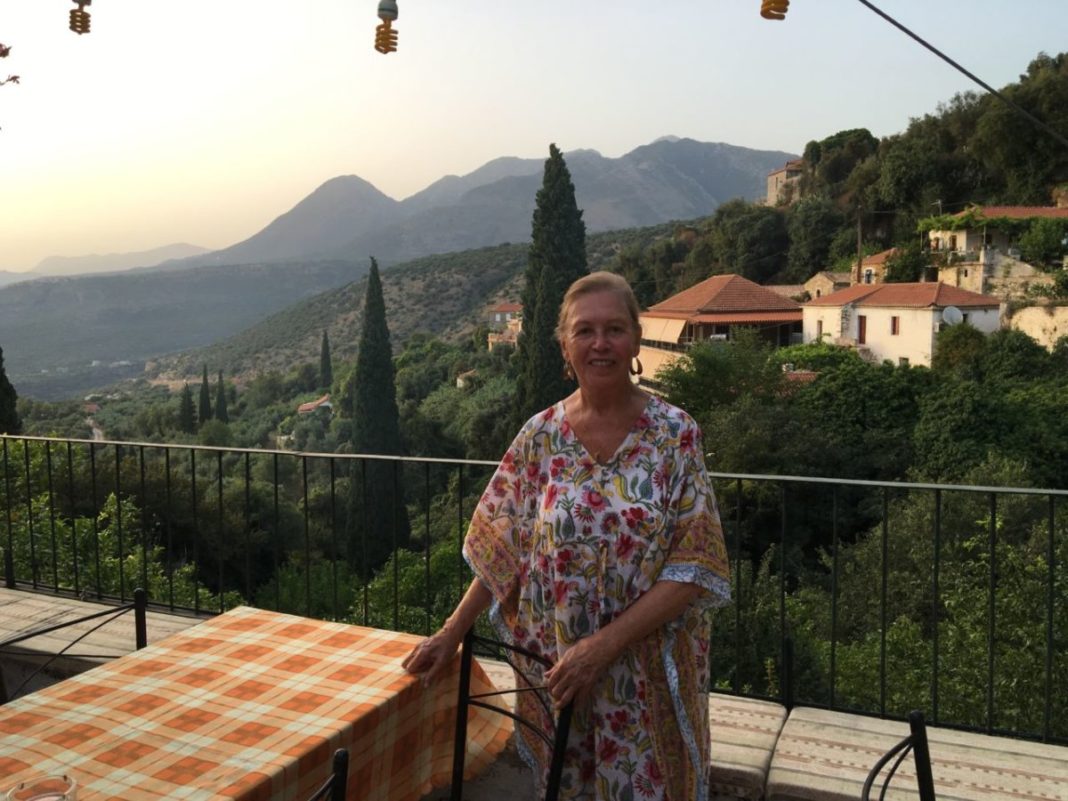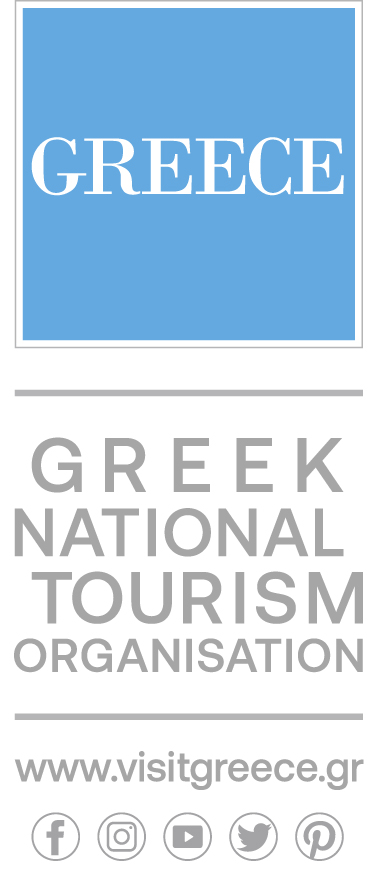By Aurelia Special to the Hellenic News of America
“Seven well-peopled cities will I give him, The first of which is Kardamyli Neigh to the sea…. Homer, The Iliad
There are many ways a landscape can seduce a person and one of the most subtle, yet powerful, is by its innocence. When one first steps on certain “sacred ground,” as the author, Lawrence Durrell, referred to the soils of Greece, the senses appear to be sleeping. And then slowly there is an awareness that something is missing. The eyes and ears are alert because they are no longer being assaulted with raucous sights and sounds. Air is fresh with the scent of rosemary and thyme and fragrance of the oleanders. One can almost taste the salt of the sea. The baby-blanket blue sky and pillow-soft clouds linger lightly above, almost begging to be touched.
Welcome to the idyllic, very traditional village of Kardamyli, first mentioned in writing 3000 years ago by Homer in The Illiad and offered as a gift by King Agamemnon to Achilles. It seemed that the King coveted a maiden seduced by Achilles and to make her his own, he offered his daughter in marriage to the warrior. To sweeten the offer, he added a dowry of seven cities, the first of which was Kardamyli.
The Village is on the mainland of Greece in an area known as the Peloponnese or Peloponessos. In the southern part is the Mani, crowned by the Taygetus Mountains, and washed by both the Aegean and Ionian seas. Maniouts will tell you the mountains stretch over a hundred miles “as the crow flies.” In the north are the foothills of Morea and the southern end is called Teharon (Cape Matapan).
Slim towers of rugged rocks, stripped naked by the burning sun, shoot upward, punctuating the landscape. In centuries past, each family of prominence and influence had a tower (Pyrgo in Greek) as a means of protection against invaders. The towers were unoccupied except in times of invasions; the ancient remains of many of these fortresses stand today, as immovable as frozen sentries. The powerful families in the Mani were those who owned and controlled large areas of land; the towers, stormed and occupied by armed sentries at the slightest hint of intrusion, were the means of protecting the land.
The strength of individual clans could be seen in the height and armament of the structures, as it required amble resources to build and maintain them. They were tall and slender and designed for protection, not for living. Historians point out that after 1830, larger, wider towers were built, but were occupied only by the leader of the clan.
Kardamyli today is inhabited by approximately 500; the central area, or agora, with shops and tavernas side by side, is compact and one can walk from one end to the other in a little more than ten minutes. A local resident told me that what distinguishes Kardamyli from other places where tourist flock in the summer is that it is a Village first and a tourist destination second. He believes its uniqueness as a sleepy, traditional Village will prevail because those who live here will have it no other way. All establishments are family owned (many owners are women) and local artists and craftsmen are the creators of the arts and crafts sold. There is not a MacDonalds or Starbucks in sight. The bus provides service to nearby villages and to Athens, but only one taxi serves tourists. The Bank of Piraeus has an ATM machine; one can enter the bank itself, however, only on Wednesdays, the one day of the week it is open for business.
I was guided in my initial exploration of the Village by the personable Alexandros Koutsos, a travel professional who is Manager of View Travel and a representative of Lilliput Register travel agency. His agency specializes in arranging travel and accommodations for tourists from Norway, but he offers these same services, including , travel to and from Kardamyli, and excursions throughout the Mani for anyone. Mr. Koutsos is fluent in Greek, English, and German, and manages well in Norweign; he can communicate in other languages as well. I highly recommend him to travelers from American who want to visit Kardamyli and other areas in the Mani. For tourists from the States, Mr. Koutsos should be your first stop in the Village to receive an orientation and plan excursions. ([email protected])
There are more than twenty shops selling handmade gifts, organic beauty cosmetics, local products, such as honey and olive oil, Village sweets and specialities, fine arts and crafts, bric-a-brac, glass beads, antiques, attire, and accessories. Many of the garments are made of the softest and finest pure cotton, difficult to find in the States. You will find the ubiquitous news stand, where one can buy the International New York Times, all the major papers printed in the UK, and newspapers and magazines in a number of foreign languages.
One of my favorite antique and clothing store shops is owned and operated by Mariekaty Athanasea Georgota, who is a treasure trove of information about the history and culture of Kardamyli. She and her friend, Professor Emeritus Frederick Osmand Gearing, an anthropologist at the University of Buffalo, co-authored “From the Edge of Greek Space,” an examination of Kardamyli and the fifty villages and surrounding countryside comprising the “ExoMani.” Mariekaty Georgota has roots in Kardamyli, was a Fulbright Scholar, and the recipient of the Ipetski Award for her book, “The Other Turkey.” She is a serious student of biological sciences and literature and earned her degree from The American College in Athens.
Stop in her shop to browse among the antiques, chose your purchases from the distinctive array of unique, jewelry, antiques, and designer clothing from Athens, and engage Mariekaty in conversation about her fascinating life. Another shop I stopped in almost every time I passed is simply called “The Bead Shop,” owned and operated by Gill Rochelle, formerly from the UK. She makes a wide variety of colorful jewelry and sells swimwear and bags decorated with beads of every color.
One of the most popular stores for outdoor enthusiasts is 2407, selling bicycles and hiking gear. The shop’s owner plans excursions and hikes and helps tourists organize their own water and hiking adventures. Many athletes of all ages come here for the outdoor adventures and I will be writing a separate article on all that is offered by 2407. There is also a “Dive Center” that is very popular. The Messenia Bay, beloved by swimmers and snorkelers, is beautiful and unpolluted with deep vistas..
Visitors have a choice of staying in apartments, studios, hotels, maisonettes, and villas. There are approximately fifty choices. I choose Marina’s Studios, situated above the bay. My studio is clean and comfortable, with WIFI, a refrigerator, hot plate, television, and cleaning service every day. I have a spacious patio where I have my morning breakfast and watch the drama of the rising sun. Marina’s is next door to Les Sirenes, another superb studio, and to me, these are among the most desirable places to stay in Kardamyli. (Send an email to [email protected] for both). The wise visitor who wants to return to either Marina’s or Les Sirenes knows to make her reservation before she leaves (my reservation for next year is set in stone).
For the past fifteen years, Marina’s Studios have been owned and operated by the husband and wife team of Marina and Eddie Haralambeas,. Les Sirenes, which translates as “Mermaids,” has been owned and operated by Mrs. Semiramis Villoti for the past three years. Both Marina’s and Les Sirenes offer four fully equipped studios with free WiFi and are open year-round. Situated directly on the bay, they are renovated in a light and cosy style and have sea views with balconies. Plenty of free parking spaces adjoin the establishments.
Below both is the very popular Harilaos Restaurant, serving delicious traditional Greek and Mediterranean cuisine and also fish caught that morning by local fishermen. Word spread quickly yesterday when fishermen arrived with a catch of red mullet and I hurried to Harilaos to reserve them for my dinner.
Other very popular and most desirable hotels, and where many visitors from the UK and Scandinavia choose to stay, are the Anniska and Liakoto (www.aniska-Liakoto.com); they are owned and operated by the Paliatseas family. Liakoto features a swimming pool and Anniska has a beautiful sea front terrace—perfect for morning breakfasts and enjoying a glass of wine in the evening as you watch the sun set over the Messinian Bay. These hotels are excellent choices for stays in Kardamyli.
Opening in 1992, the Anniska offers twelve one bedroom apartments and ten studios, three of which are absolute sea views and the rest offering distant sea views and garden/mountain views. . The Liakoto, which opened in 2002, has nine one bedroom apartments, three two bedroom suites, and twelve studios; all the rooms at Liakoto have absolute front sea views (there are three rooms that have distance sea views). The hotels are open from the beginning of April until mid-November.
Most of the guests are those who have been returning year after year. News of these extraordinary desirable studios and apartments spread by word of mouth. Guests who come during the off season are here for olive picking, walking, photography, or to see the flowers in bloom. Winters in Kardamyli are mild.
The very accommodating, warm, and personable Stephen Manley-Clark serves as the Duty Manager and has been here since 2014. A former resident of the U.K., Mr. Manley-Clark was in the travel business, worked for a touring company, and was the cabin crew manager for an airline before assuming his position at the hotels. His enthusiasm for The Mani in general and Kardamyli in particular is infectious. “Mani is magical,” he says, adding “it drew me here like a magnet.” He says it is perfect for “writers, artists, and painters,” and says he chose to live here to enjoy “the simple, unspoiled life.”
Kardamyli is an excellent base to explore the rest of the Mani. There are very enjoyable events in nearby communities, such as Kalamata, which hosts a contemporary dance festival, and Stoupa, the place for concerts of classical music. Entertain yourself with a Google search to discover what attracts your fancy.
All the beaches in Kardamyli are pebble and one has to travel to nearby Stoup a (a drive of fifteen minutes) where there are two lovely sand beaches. One beach, Kalogria, is where Nikos Kazantakis wrote his masterpiece, “Zorba the Greek.” The other beach, called “the Main Beach,” is larger, but both feature many sun beds and umbrellas and there are numerous shops, tavernas, and even a large supermarket.
Traditional Greek food and grilled fish, caught that day, are served in the Villages’ very fine restaurants. Harilaos, Gialos, Lela’s and Elies have sea views and are among the most popular, but excellent home made, traditional dishes can be found in the smaller tavernas as well.
Next year will mark the fourth Annual Jazz Festival, featuring more than fifty musicians from Norway. It will begin May 13 and last a week. The entire Village participates and offers venues for the sessions, which last until the early morning hours. This year there were 54 concerts in 31 separate places. It is growing every year and for this year’s concert, jazz musicians from New Orleans joined the motley crew from Norway. As word spreads about this event, it is becoming more difficult to get accommodations. I have booked my studio for next May and urged my friends to do the same. I am promising them a Greek version of Woodstock and telling them it cannot be missed. Shall we call it “Manistock?” (Just floating this idea.)
The festival is the brainchild of Bjarne S. Aaserod, a representative of Lilleput Reiser travel agency, who has been organizing concerts in Norway for thirty years. He ran a jazz club there and promoted concerts, and when he came to Kardamyli in 2011 he brought his talents with him. Mr. Aaserod is a brilliant organizer who arranged free travel and accommodations for the musicians from Norway. Expenses were covered by two methods: a raffle and passing the plate. Mr. Aaserod praised the people and business people of Kardamyli for the hospitality they offered to make the festival a huge success. As musicians from places other than Norway hear about the festival and ask to participate, they are welcomed, and have no objections to paying their own expenses. (I find prices for accommodations and dining here to be very modest.)
Most visitors who come here are from the UK (there is a direct flight that takes only three and a half hours), from Norway, Germany, Switzerland, and of course, from other areas of Greece. Visitors from the States are few, and that may be because one has to take several flights to get here. The most direct route from the US is to fly from London to Kalamata, and then take a taxi (the ride is about 45 minutes) to Kardamyili. Or, take a direct flight from New York to Athens and then to Kalamata.
A major attraction that draws people from all over the world here is the home of Patrick Leigh Fermor, the renowned author, travel writer, and war hero who joined with the ragtag fighters on Crete to fight the Germans when they invaded the island during World War II. Fermor, who was in his early twenties, famously captured a German general and put him on a boat for Egypt, causing a sensation and giving birth to the legend of his exploits as a fearless adventurer. Prior to the war, he walked from the Horn of Holland to Constantinople and wrote a trilogy describing his adventure. In middle age, Fermor and his wife, Joan, built a stone home in Kalamitsi, near Kardamyli, where he wrote and offered hospitality to many visitors who came to see the famous man. It is now a shrine. Fermor, who died in 2011, willed it to the BENAKI Museum, stipulating that it should be offered for short periods to writers. (I have added my name to the list of writers who long to spend time in this precious place, and I am hoping we are selected in alphabetical order;-). The Fermor is visited yearly by a growing number of pilgrims. Arrangements for visits must be made through the BenakI Museum; you will find a link for reservations on the Museum’s website.
Kardamyli is as beautiful today as it must have been in ancient times, for why else would it be first on the list of seven cities offered to Achilles for the maiden (of all the maidens, she must have been the fairest, envied by Aphrodite herself;-)
Some say the fates have watched over Kardamyli from Homer’s time until now and that they protected its singular beauty. They say nothing has changed about its landscape and its innocence. As proof they offer the fact that the names of the six other villages presented to Achilles changed over the centuries, and only Kardamyli has kept the same name. And the same innocence.
It is now time to take my leave and it is difficult. The Muses, knowing how the Village has seduced me, have given me a golden voice. I will now share my song with you. With a nod to Lord Byron and his “Ode to the Maid of Athens,” I offer my “Ode to Kardamyli:
“Kardamyli, ‘ere we part
Give, or give me back my heart
By Aurelia









